This post explains how to fix Excel Toolbar if it is not working in Windows 11/10. Excel is one of the most popular spreadsheet tools used by more than half a billion people worldwide. While working with Microsoft Excel, a few users have reportedly faced a strange error where the icons on the toolbar stop responding to the mouse. For example, when they try to click on the ‘File’ menu to access the ‘Save’ or ‘Print’ command, the mouse click doesn’t work. Also, the commands are not highlighted when the mouse pointer passes over them. If you’re facing a similar issue and want to figure out how to fix the problem, then keep reading this post.
![Excel Toolbar not working [Fix] Excel Toolbar not working [Fix]](https://www.thewindowsclub.com/wp-content/uploads/2023/01/Excel-Toolbar-not-working-Fix-1.png)
Fix Excel Toolbar not working
The Excel toolbar may not be working on your Windows 11/10 PC due to various reasons. One primary reason is a corrupt Excel toolbar file. Other reasons could be damaged system files, customized add-ins, or conflicting third-party apps.
For most of the users, the issue subsides when they resize the program window using the mouse or using the maximize/minimize icons. For some, the issue resolves when they click anywhere in the desktop area and then again click on the spreadsheet. However, these are just temporary fixes. In order to resolve the issue permanently, we recommend using the following solutions:
- Reset toolbar settings.
- Rename the corrupt toolbar file.
- Troubleshoot Excel in Safe mode.
- Repair Microsoft Excel.
- Troubleshoot in a Clean Boot state.
Let us see these in detail.
1] Reset toolbar settings
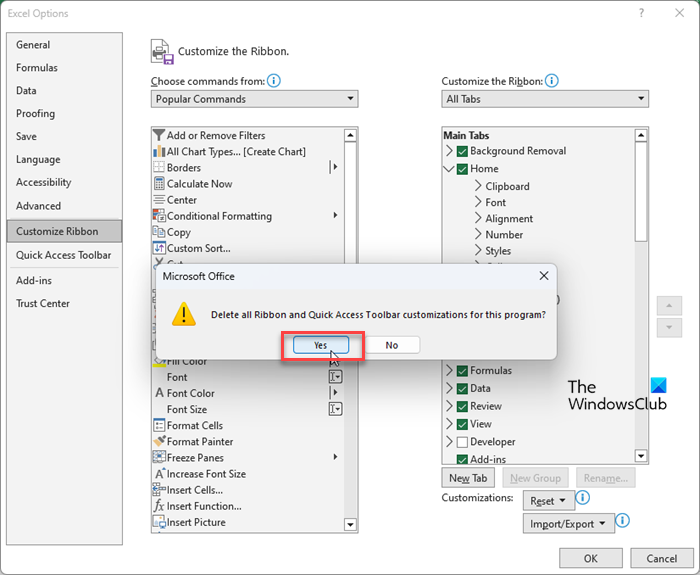
Start by resetting the customizations you have made to the Excel toolbar.
- Go to File > More… > Options. This will open the Excel Options window.
- Click on Customize Ribbon in the left panel.
- Select All Tabs in the Customize the Ribbon dropdown on the right-hand side.
- Make sure all the options are selected in the list box just beneath the dropdown.
- Click on the Customizations dropdown below the list box and click on the Reset all customizations option.
- Click on the Yes option in the alert that appears.
This will delete all the customizations for Ribbon and Quick Access toolbar tabs and reset the default settings for the program. Once you do this, try using Excel again and see if it fixes the issue.
2] Rename the corrupt toolbar file
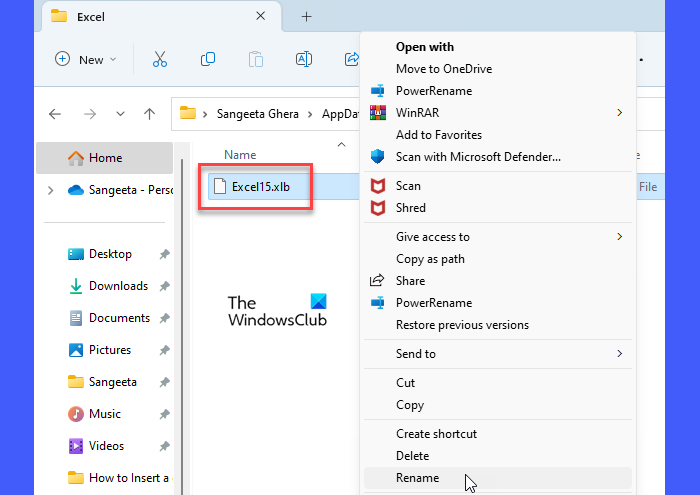
If the issue is due to a corrupt toolbar file, fixing it may resolve the problem. When you rename a corrupt toolbar file, Excel rebuilds a new toolbar when it restarts.
- Open File Explorer and copy-paste the following in the address bar: %AppData%\Microsoft\Excel.
- Locate the Excel.xlb or Excel15.xlb file (for Excel 2013, 2016, and 2019/365).
- Right-click on the file and select Show more options.. > Rename.
- Rename the file as Excel.xlb.old or Excel15.xlb.old and press the Enter key.
- Reboot your PC.
- Restart Excel and see if the issue is fixed.
Also Read: Best Excel Repair Tools & Methods to repair corrupted Excel file.
3] Troubleshoot Excel in Safe mode
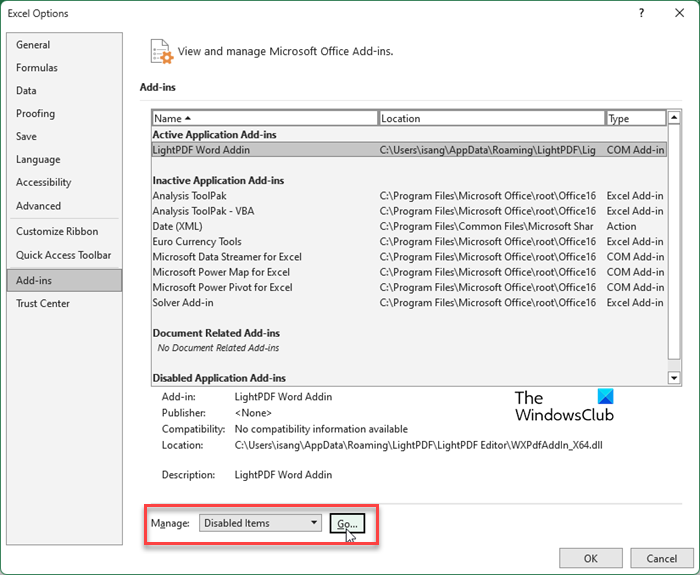
If the issue persists, try starting Microsoft Excel in Safe Mode. Safe mode is a diagnostic mode in which the program starts with basic features. Safe mode checks for corrupted resource files, registry entries, or templates. It also disables all the add-ins and menu customizations, so that you may enable them one by one (manually) to identify the problematic item.
- Go to File > More… > Options > Add-ins.
- In the Manage dropdown at the bottom, select Disabled items and click on the Go button.
- From this list, select one item and enable it. See if it causes the problem. If it doesn’t cause the problem, enable another item. Keep doing this until you find the problematic item. If you find one, consider removing it.
- Close Excel to exit the safe mode.
4] Repair Microsoft Excel
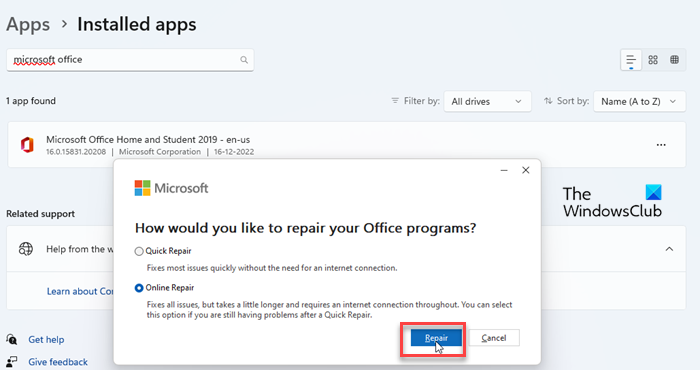
Next, repair the Microsoft Excel program using Microsoft’s Quick Repair/Online Repair tool. This will attempt to repair any corrupt program files if Excel is not working correctly.
- Close Microsoft Excel.
- Make sure you’re connected to a stable internet connection.
- Press the Win key on your keyboard.
- Select Settings.
- Click on the Apps option in the left panel.
- Then click on Installed Apps in the right panel.
- In the search bar on top, type ‘microsoft office’
- The search results will show the Office version installed on your system.
- Click on the options icon (three horizontal dots) next to it and select Modify.
- Select Yes in the UAC prompt that appears.
- In the window that appears, select the Online Repair option and click on the Repair button. This is applicable to a Click-to-run based installation. If you have an MSI-based installation, select Repair and then click on Continue in the Change your installation window.
- Follow any on-screen instructions and wait for the repair process to finish.
- Restart Excel and see if the issue is fixed.
Note: The above process will repair the entire Office suite. If you have Excel installed as a standalone application, you can search for it and repair it individually.
5] Troubleshoot in a Clean Boot state
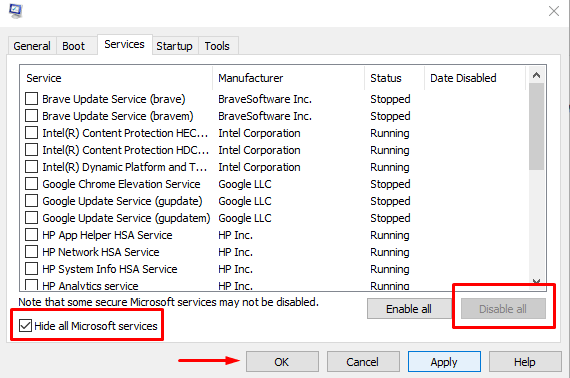
If the above solutions won’t help, the root cause may lie with some external application rather than Excel itself. If that’s the case, troubleshooting Windows in a Clean Boot state may help identify the conflicting third-party app.
Only Microsoft services are made to run during a clean boot so that the non-Microsoft product that’s causing software conflicts may be identified. Once you enter the Clean Boot state (by disabling the non-Microsoft services and startup programs), try using Excel again. If the toolbar works properly, you can rest assured the issue is with some third-party app or service. Now you have to re-enable the services and startup programs one by one to pinpoint the problem. Once you find the conflicting app, consider removing it from your Windows 11/10 PC.
Hope the above solutions will help resolve the Excel toolbar not working issue.
How do I enable the toolbar in Excel?
To show/hide or restore a missing toolbar in Microsoft Excel, click on the Ribbon Display Options button in the top-right corner of the program window. Then click on Show Tabs and Commands option. This will show the ribbon in full-view mode, displaying all the tabs and commands. You can also use the Ctrl+F1 hotkey to collapse/show the ribbon. If you’re still not able to enable it, check the list of disabled items in Excel.
Read Next: Excel filter not working properly.
Leave a Reply